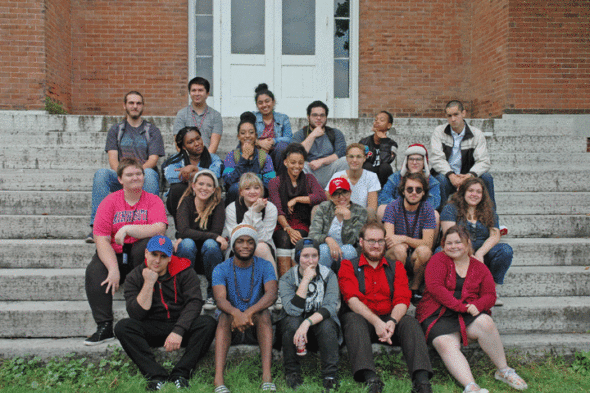New Antioch class small but diverse
- Published: October 19, 2017
Maricruz and Rafael Flores drove their son, Diego, 1,100 miles from Houston to Yellow Springs last week, arriving two days before move-in. Diego had chosen Antioch College on his own, Maricruz explained, and this was the couple’s first chance to see the campus that would be their son’s home for four years.
“We love it,” she said.
Rafael Flores said he felt comfortable leaving his son at Antioch — except for one thing. “I don’t want to leave. I want to come here,” he said, smiling.
The family’s home was hit in August by Hurricane Harvey, and Diego had spent his last weeks before college helping his parents and an aunt clean up from the storm. The damage “wasn’t bad — only two feet of water,” he said.
The Flores family was one of several groups of parents and students gathered at the newly renovated Weston Hall “C-shop” for final good-byes last Thursday evening. Thursday was move-in day for new students, and classes began earlier this week.
A mother-daughter pair from Columbus, Catherine Chapman and Sarah Mills, stood talking nearby. Chapman said she was “just tagging along,” as her daughter, a 24-year-old art student, had decided on Antioch independently. Asked what she thought of the college so far, Chapman paused.
“Yeah, what do you think?” Mills interjected.
“I’m just excited for you. I support you in your choice,” the mother replied.
Chapman later added, “I think she’s going to fit in with the students here. She’s naturally a leader.”
Twenty-eight in new class
Diego Flores and Sarah Mills are among the 28 new students enrolled at Antioch this fall. Sixteen, or nearly 60 percent, are from Ohio, including at least two students from Yellow Springs. Twelve students hail from nine other states: Arizona, California, Florida, Minnesota, New Jersey, New York, Oregon, Pennsylvania and Texas.
The new class is notably diverse: almost 50 percent are students of color, according to figures provided by the college. Specifically, five students identify as being of two or more races, three as black or African American, two as Native American, three as Hispanic/Latino and 14 as white. Four didn’t disclose race.
About 60 percent, or 17 students, are women, while 10 are men and one student identifies as nonbinary.
Nineteen students are first-years, while nine, or nearly one-third, are transfers from other four-year colleges or community colleges.
And seven students, or one-quarter of the class, are the first in their families to attend college.
Based on conversations with about a dozen new students last week, students’ academic interests range from media arts, writing, psychology and medicine to social justice, sustainability and political science. Some already have career plans in mind.
New student Maria Lopez, of New York City, hopes to become a veterinarian. Jade Marshall, of Dayton, aims to enter medicine, while Angel Carter, of Springfield, Ohio, aspires to work as a journalist covering civil rights issues.
Another student, Aaron Westbrook, of Columbus, is already the CEO and founder of a company, Form5 Prosthetics, which uses recycled materials to make low-cost 3D-printed prosthetics. When Antioch accepted him, it also offered his company space on campus. Westbrook plans to design his own major around 3D printing, combining engineering, entrepreneurship and art.
Smaller than hoped
While lively and diverse, the new class is substantially smaller than college leaders hoped. This year’s class, the seventh since the college reopened to students in 2011, is the smallest class of the revived Antioch. The college’s first class enrolled 35 students, followed by classes of 75, 101, 71, 66 and 43 students, according to previous News reports.
Overall enrollment currently stands at 135, according to figures provided by the college this week. Last year, the college enrolled a total of 220 students, according to a Sept. 5, 2017, report in Insider Higher Ed.
This is the third consecutive year Antioch has fallen significantly short of its enrollment goals. Its target for the class entering this fall was 60 students, according to President Tom Manley last spring. With just 28 enrolled as of last week, the college has missed that target by more than half.
Antioch recently hired back its former communications chief, Gariot Louima, as the new dean of admissions and external relations. Louima said last week that he is “still unpacking” the college’s recent enrollment shortfalls.
“The switch from the full Horace Mann Fellowship was definitely a factor,” he said, referring to the four-year, full-tuition scholarships offered to each of the first four classes after Antioch’s reopening. Subsequent classes, from 2015 through this fall’s, have received half-tuition fellowships, with many students also getting other forms of aid from the college. Enrollment declines coincided with the cutbacks in Horace Mann funding.
Tuition for 2017–18 is $34,568, unchanged from last year. The total annual cost of attending Antioch currently stands at just over $55,000, according to the college’s website.
College leaders have previously cited turnover in the admissions department as another factor hampering recruitment. Instability continued this year, with the departure of former Dean of Admission Bill Carter, who had a heart attack last spring, after just seven months on the job.
Louima, who returned to Antioch last month following four years as enrollment dean at Vermont’s Goddard College, said Antioch leaders have set a “clear target” for the class entering in 2018. That target is 75.
Getting there won’t be easy, he conceded. “Small liberal arts colleges are having a tough go of it,” he said.
According to Louima, Antioch received 171 completed applications last year, and accepted 159 students, or about 93 percent. Twenty-eight students, or 17.6 percent, chose to enroll at the college.
A recruitment plan and budget for next year have not yet been set. But Louima said strategies he favors include deepening alumni and faculty involvement in recruitment, targeting a few key geographic areas, showcasing recent graduates’ successes and emphasizing Antioch’s distinctive co-op program.
“We have to clarify who we are and what we offer,” he said.
Why Antioch?
Nadia Mulhall, who grew up in Yellow Springs and is the daughter of Jackie and Kevin Mulhall, the latter the library director at the college, said she never imagined herself at Antioch. A 2015 graduate of Yellow Springs High School, she attended Ohio University for two years, studying art history and studio art. But the university felt “too big,” and the educational program “just wasn’t malleable enough for me,” she said. Plus, she was interested in studying abroad — on her own terms, not as part of a “curated study abroad program.”
By contrast, Antioch’s small community, flexible curriculum and co-op program all seemed to fit. She applied as a transfer student, and was accepted.
“It’s odd to be back. But good,” she said last Saturday, registering for fall classes.
Other new students and parents interviewed by the News in recent days echoed similar themes, citing co-op, the college’s commitment to social justice and its small size and caring community as their top reasons for choosing Antioch. Some area residents highlighted Yellow Springs itself as a draw.
“I love it here,” Angel Carter said. A Springfield resident, she has spent substantial time in the village since she was a child, including as a participant in YS Kids Playhouse.
While one student interviewed was the son of an alumnus, other students and their parents said they knew little, if anything, about Antioch before learning about the school at a college fair or from a high school counselor. Another common theme was that students themselves, not parents or others, had identified Antioch as the place where they believed they could thrive.
“This college is me. It’s artsy and quirky,” said Anna Kofron, of Cincinnati, who is interested in art and animation.
The degree of personal attention shown by Antioch convinced another artistically inclined student, Sarah Mills, to consider the college. “They reached out back to me,” she said.
Aaron Westbrook, the founder of Form5 Prosthetics, said only Antioch offered him the flexibility to design his own major in 3D printing and continue running his company on site.
“I didn’t want to be in a box for four years,” he said.
Recognizably Antiochian
No one interviewed expressed concerns about the college’s closure in 2008, or raised questions about its stability now.
Lisa Evans, mother of new student Noah Evans said the closure crossed her mind for “half a second.” Noah, a Centerville resident, had already committed to Ohio University when he got a “late call” from Antioch admissions. He visited the college, and immediately changed his mind about OU. Antioch just seemed like the perfect fit, Lisa Evans said.
“He’s hugely committed to social justice. Horace Mann’s comments — that’s this kid,” she explained, referring to the oft-quoted line from Antioch’s first president, “Be ashamed to die until you have won some victory for humanity.”
And many new students last week seemed to embrace another aspect of the college’s relaunch — its tiny size.
“I feel like there are more opportunities with a small college. You’re more involved in the community,” Jade Marshall said.
According to fourth-year Antioch student Angel Nalubega, helping out with the new student orientation, that intimacy is both difficult and rewarding. “It’s intense,” she said. “Everyone treats you like a human being here. But don’t be shocked when people are honest and tell you how things you’re doing affect them.”
To alumnus Jennifer Berman, associate director of restorative practices, the wonder of the revived college is that the “new” Antioch still manages to recruit students who are, well, recognizably Antiochian.
“And if they’re not at first, through co-op they’re transformed into that — whatever ‘that’ is,” she said. “Two co-ops later, they’re running the place.”
The Yellow Springs News encourages respectful discussion of this article.
You must login to post a comment.
Don't have a login? Register for a free YSNews.com account.

Parkinsons.jpg)














No comments yet for this article.